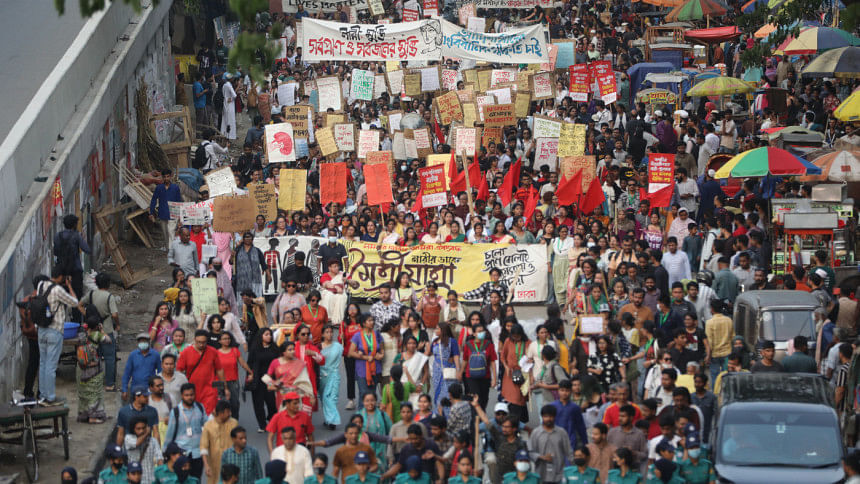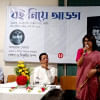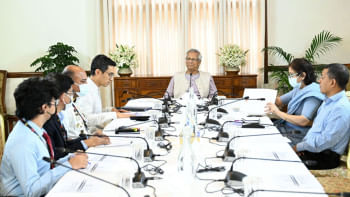Whose feminism is it anyway? : Lessons from the gender reform uproar

In recent weeks, the Women's Affairs Reform Commission submitted a report with 433 recommendations, including proposals for equal rights in inheritance, marriage, and divorce. These recommendations have faced substantial opposition from religious groups such as Hefazat-e-Islam, which argue that such reforms contradict Sharia law and threaten religious principles.
The backlash exposes a deep resistance to gender equality, with female autonomy often cast as a threat to traditional values disrupting the moral order. As women across Bangladesh take to the streets both for and against feminist reform, the liberal feminist movement faces a reckoning. The question is not why some women resist emancipation, but what kind of feminist vision has failed to earn their trust. If reform is seen as a foreign imposition, we must rethink not just the message, but the method.
Feminist backlash or feminist voice?
The sight of hijab-wearing women protesting reforms unsettled many liberal commentators. But dismissing them as pawns of particular groups is unwise as well. Many of them belong to the women wings of Islamist parties, madrasa networks, and community groups. Their presence is vocal, strategic, and moral.
However, their feminist counterparts have failed to make room for them. In Bangladesh, liberal feminism has long been perceived as centring on the secular, urban woman as its ideal. This has created a narrow and exclusionary vision of liberation. Moreover, mainstream feminist discourse has privileged economic emancipation as the key metric of liberation. This economistic framing often ignores structural patriarchy that shapes women's lives beyond the marketplace. By focusing on income over power and autonomy, feminism risks reinforcing the systems it seeks to dismantle.
Engaging Muslim women doesn't mean compromising principles; it means recognising their autonomy and understanding that their critiques often arise from historic exclusion. But inclusion must be critical: in Bangladesh, male-dominated interpretations of Islam continue to shape public perceptions of gender and law. The issue isn't the presence of religious women, but the uncritical acceptance of patriarchal authority. We must ask: who benefits when liberatory readings are sidelined?
Policing morality, policing access
In recent weeks, feminist contestation in Bangladesh has unfolded not only between secular and religious forces but also within platforms that claim inclusivity. The Narir Dake Moitree Jatra procession, organised to counter reactionary backlash and advocate for gender equity, presented itself as a space of solidarity and diversity.
The visual economy surrounding Moitree Jatra disproportionately centred on established, urban, secular feminist figures—those already recognised within progressive circuits. While their presence is significant, such framing risks reinforcing a limited paradigm of feminist legitimacy. Despite the spirit of inclusion, media coverage focused on familiar figures, established activists, and recognisable faces. These images risk reinforcing a narrow visual vocabulary of feminist legitimacy: urban, unveiled, youthful, and fashionably gendered. Meanwhile, Indigenous women, garment workers, hijra individuals, and others appeared limited.
Mainstream and social media focused on a narrow slice of Moitree Jatra, overlooking domestic workers, housewives, madrasa students, slum dwellers, and members of the gender-diverse community; voices that are vital yet routinely erased. This selective gaze, shaped by media logic and algorithms, reinforced class hierarchies and left the movement vulnerable to charges of elitism. Right-wing actors weaponised the imagery, accusing participants, especially garment workers, of immorality or of being paid to attend. This classist backlash, echoed across conservative and liberal camps, reveals a deeper discomfort with working-class and gender-diverse political agency. Feminism must ask: whose presence is seen as political, and whose participation remains up for debate?
Urban optics, rural silence
The recent targeting of Nadira Yeasmin, an assistant professor and grassroots feminist organiser in Narsingdi, exposes the selective nature of both state protection and feminist solidarity in Bangladesh. On May 25, Hefazat-e-Islam's district branch held a rally condemning the published pieces on women's property rights in Hisya, a small literary magazine run by Yeasmin's collective, Nari Angan. They accused her of mocking Islam and issued a 48-hour ultimatum for her removal. Within a day, the education ministry transferred her to a remote college in Satkhira, citing only "administrative reasons."
This is not merely about Nadira Yeasmin. It is about the political message her targeting conveys: that women who speak from the peripheries, outside Dhaka's urban, institutional circuits, remain vulnerable and unsupported. What renders this silence even more troubling is the context in which it occurs. The current government positions itself as progressive and reform-oriented, investing in policy consultations, legal commissions, and donor-friendly frameworks to signal its commitment to gender equality. Yet, when a rural educator faces public threats for addressing women's legal rights, these reformist gestures ring hollow. The disjuncture between institutional rhetoric and grassroots protection reveals the limits of a feminism that is performative at the centre but mute at the margins.
The question, then, is not simply who speaks, but whose speech is safeguarded, amplified, and deemed legitimate. If feminist reform cannot defend a woman in Narsingdi, it cannot claim to represent the full spectrum of women's struggles.
Whose voices shape reform?
The reform commission, though progressive in intent, faltered in execution. Its optional civil frameworks were perceived as attacks on religious law. The optics of imposition outweighed the substance of choice.
The exclusion of marginalised voices within the reform structure is systemic, not incidental. As long as power remains concentrated in the hands of a privileged few, reforms will reflect narrow interests. The problem with reform lies not just in whom was consulted but in methodology. Feminists have struggled to represent all women, not because the goals lack legitimacy, but because the movement often bypasses religion. When empowerment is framed through secular, donor-friendly terms and religion is treated as regressive, the movement loses moral resonance.
Legal feminism often functions as a technocratic intervention, delivered to women rather than developed with them. It prioritises visibility over deep engagement. By engaging only superficially with religious discourse and framing empowerment in apolitical terms, it risks reproducing the very exclusions it critiques. Without grounding reforms in culturally resonant narratives and participatory dialogue, the movement appears elitist and disconnected.
Towards a feminism that listens before it leads
What's needed isn't a retreat from reform, but a reimagining of it. Bangladeshi feminism must shift from deliverance to dialogue, meeting women where they are, embracing pluralism, engaging faith, and centring the most marginalised. This means building slow, non-linear coalitions, embracing contradictions, and recognising that liberation has no single name, language, or dress code. The question is no longer why Muslim women reject reform, but rather why feminism hasn't yet offered a vision all women can claim as their own.
Tara Asgar is an artist, educator, and activist.
Nur A Mahjabin Khan is a researcher specialising in media and communication.
Views expressed in this article are the author's own.
Follow The Daily Star Opinion on Facebook for the latest opinions, commentaries and analyses by experts and professionals. To contribute your article or letter to The Daily Star Opinion, see our guidelines for submission.

 For all latest news, follow The Daily Star's Google News channel.
For all latest news, follow The Daily Star's Google News channel. 








Comments